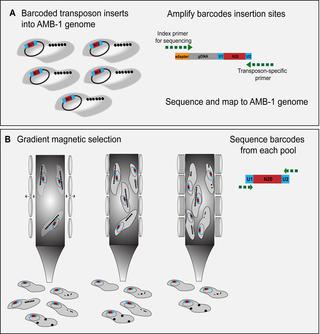当前位置:
X-MOL 学术
›
PLOS Genet.
›
论文详情
Our official English website, www.x-mol.net, welcomes your feedback! (Note: you will need to create a separate account there.)
Magnetic genes: Studying the genetics of biomineralization in magnetotactic bacteria.
PLOS Genetics ( IF 4.5 ) Pub Date : 2020-02-13 , DOI: 10.1371/journal.pgen.1008499 Hayley C McCausland 1 , Arash Komeili 1, 2
PLOS Genetics ( IF 4.5 ) Pub Date : 2020-02-13 , DOI: 10.1371/journal.pgen.1008499 Hayley C McCausland 1 , Arash Komeili 1, 2
Affiliation

|
Many species of bacteria can manufacture materials on a finer scale than those that are synthetically made. These products are often produced within intracellular compartments that bear many hallmarks of eukaryotic organelles. One unique and elegant group of organisms is at the forefront of studies into the mechanisms of organelle formation and biomineralization. Magnetotactic bacteria (MTB) produce organelles called magnetosomes that contain nanocrystals of magnetic material, and understanding the molecular mechanisms behind magnetosome formation and biomineralization is a rich area of study. In this Review, we focus on the genetics behind the formation of magnetosomes and biomineralization. We cover the history of genetic discoveries in MTB and key insights that have been found in recent years and provide a perspective on the future of genetic studies in MTB.
中文翻译:

磁性基因:研究趋磁细菌中生物矿化的遗传学。
与合成材料相比,许多细菌可以更精细地制造材料。这些产物通常在带有许多真核细胞器特征的细胞内隔室内产生。一个独特而优雅的生物体处于细胞器形成和生物矿化机制研究的最前沿。趋磁细菌(MTB)产生称为磁小体的细胞器,该细胞器包含磁性材料的纳米晶体,了解磁小体形成和生物矿化的分子机制是一个研究领域。在这篇综述中,我们着重于磁小体形成和生物矿化的遗传学。
更新日期:2020-03-05
中文翻译:

磁性基因:研究趋磁细菌中生物矿化的遗传学。
与合成材料相比,许多细菌可以更精细地制造材料。这些产物通常在带有许多真核细胞器特征的细胞内隔室内产生。一个独特而优雅的生物体处于细胞器形成和生物矿化机制研究的最前沿。趋磁细菌(MTB)产生称为磁小体的细胞器,该细胞器包含磁性材料的纳米晶体,了解磁小体形成和生物矿化的分子机制是一个研究领域。在这篇综述中,我们着重于磁小体形成和生物矿化的遗传学。



























 京公网安备 11010802027423号
京公网安备 11010802027423号